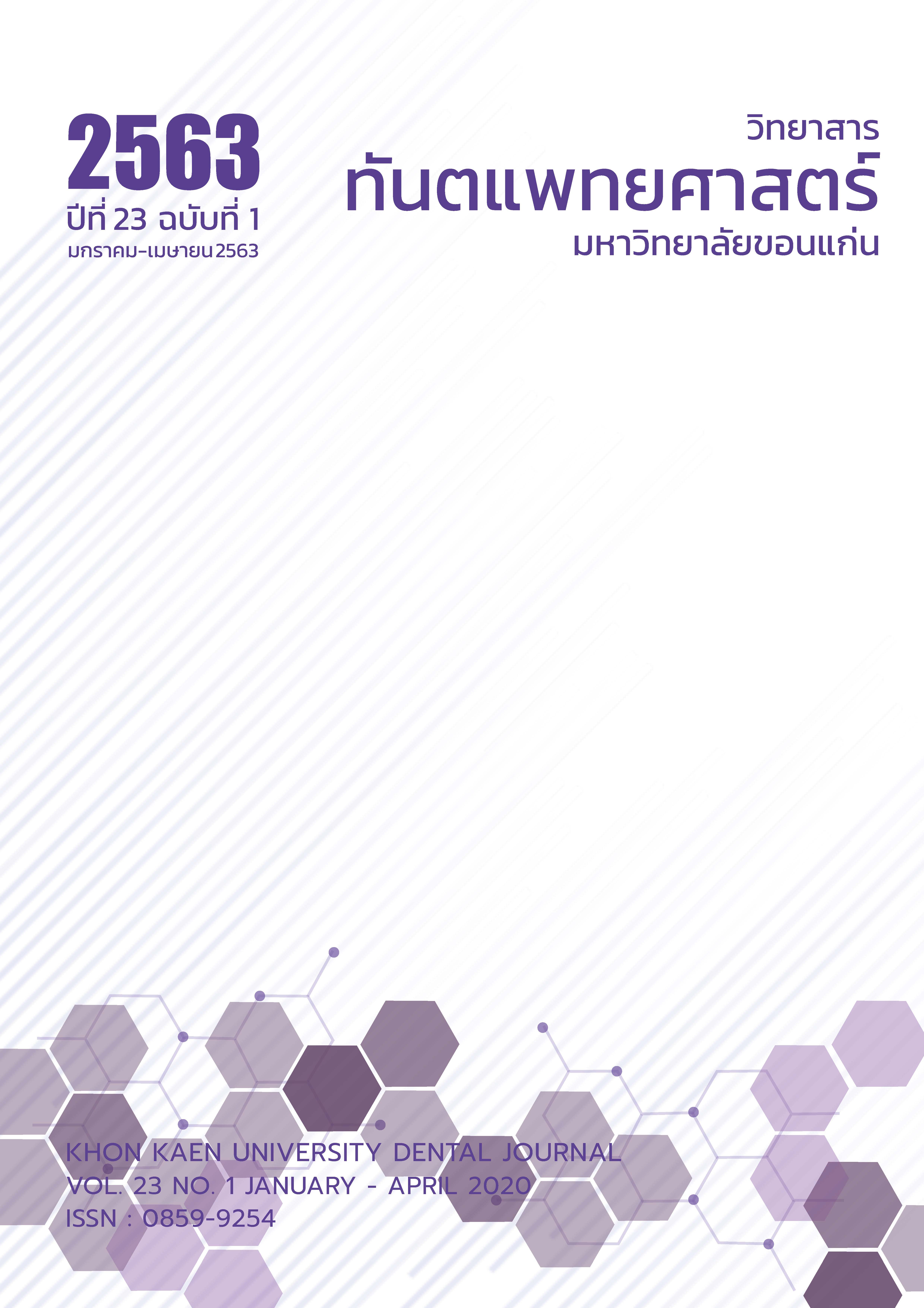Comparison of Wear Resistance, Surface Hardness and Surface Roughness of Dentoform Tooth and Silane-treated Alumina Reinforced Epoxy Resin
Main Article Content
Abstract
Dentoform teeth are extensively used in the preclinical laboratory practice by dental students. Nowadays, the price of the dentoform teeth has been increased continuously. Therefore, the substitute materials were developed in order to reduce the imported teeth thus reducing the education expenses for dental students. The purpose of this study were to compare wear resistance, surface hardness and surface roughness of dentoform teeth (Frasaco, German; Nissin, Japan) and epoxy composite (70 wt% un-treated alumina and 50, 60, 70 wt% silane-treated alumina reinforced epoxy resin) when unfilled epoxy resin served as control. Fifteen specimens of each group (n=15) were examined for pin-on-disk wear resistance, Vickers surface hardness and contact stylus profilometer surface roughness. One-Way ANOVA statistic was used to analyze the data (a = 0.05). It was found that wear resistance of 70 wt% and 60 wt% silane-treated alumina reinforced epoxy resin groups (tx 70% and tx 60% groups) were significantly higher than those of the others including dentoform groups. The surface hardness of dentoform groups was significant higher than all remaining groups (Frasaco: 38.321+1.278 HV, Nissin: 39.245+2.060 HV). However, when comparing within the epoxy composite groups, tx 70% group (29.924+0.921) had been shown the significantly highest value. In surface roughness, tx 60% group had been revealed the lowest value but it was not significantly different with tx 50% and tx 70% groups. Although tx 70% group had been shown less surface hardness when compared with that of dentoform groups, its wear resistance and surface roughness had been superior than those of dentoform groups. Therefore, tx 70% should be considered as a promising and cost-effective substitute material for production of dentoform teeth.
Article Details
บทความ ข้อมูล เนื้อหา รูปภาพ ฯลฯ ที่ได้รับการลงตีพิมพ์ในวิทยาสารทันตแพทยศาสตร์ มหาวิทยาลัยขอนแก่นถือเป็นลิขสิทธิ์เฉพาะของคณะทันตแพทยศาสตร์ มหาวิทยาลัยขอนแก่น หากบุคคลหรือหน่วยงานใดต้องการนำทั้งหมดหรือส่วนหนึ่งส่วนใดไปเผยแพร่ต่อหรือเพื่อกระทำการใด ๆ จะต้องได้รับอนุญาตเป็นลายลักษณ์อักษร จากคณะทันตแพทยศาสตร์ มหาวิทยาลัยขอนแก่นก่อนเท่านั้น
References
Frazier KB, DMD. A method for mounting natural teeth in a commercial dentoform. Oper Dent 1999;24(4):245-8.
Duangduan Chamchong, S.A., Namchai Sooksunti sakunchai, Jintamai Suwanprateeb. Comparison of surface hardness, surface roughness and debris retention of dentoform tooth and replacement materials. Khon Kaen Dent J 2010;13(1):27-36.
Senthikumar N, Kalaichelvan, K, Elangovan, K. Mechanical Behaviour of Aluminum Particulate Epoxy Composite Experimental Study and Numerical Simulation. Int J Mech Mater Eng 2012;7(3):214-21.
Qiu Long Ji, MQZ, Min Zhi Rong, B. Wetzel, K. Friedrich. Tribological properties of surface modified nano-alumina/ epoxy composites. J Mater Sci 2004; 39(21):6487-93.
Melamine Plastic. 2015; Available from: https://plastics. ulprospector.com/generics/20/melamine.
Knowledge about plastic and melamine. 2015; Available from:https://www. superwaredirectsales.com/tips_pr.html.
Ramesh K. Nayak AD, BC Ray. Effect of epoxy modifiers (Al2O3/SiO2/TiO2) on mechanical performance of epoxy/glass fiber hybrid composites. Procedia Mat Sci. 2014;6:1359-64.
Ranganatha SR, VSR. Invastigation on mechanical behavior of filler Al2O3 in CFRP composites. Int J Adv Sci Eng Inf Technol 2013:105-7.
Ibtihal-Al-Namie, AAI. Manal Fleyah Hassan. Study the Mechanical Properties of Epoxy Resin Reinforced With silica (quartz) and Alumina Particles. Iraqi J Mech Matl Eng 2011;11(3):486-506.
Chung S, Im Y Kim, H Park S, Jeong, H.D. Evaluation for micro scale structures fabricated using epoxy-aluminum particle composite and its application. J Mater Process Tech 2005;160(2):168-73.
Wetzel B, Haupert F, Zhang MQ. Epoxy nanocomposites with high mechanical and tribological performance. Compos Sci Technol 2003;63(14):2055-67.
Zhang MQ, Rong MZ, Yu SL, Wetzel B, Friedrich K. Effect of particle surface treatment on the tribological performance of epoxy based nanocomposites. Wear 2002;253(9-10): 1086-93.
Kishore KK. Sliding Wear Studies In Epoxy Containing Alumina Powders. Center for Advanced Studies, Department of Metallurgy, Indian Institute of Science 1998; 17(4):271-4.
Michael Bolgar JH, Joe Groeger, Susan Meronek. Handbook for the chemical analysis of plastic and polymer additives; 2008.
Jallo LJ, Schoenitz M, Dreizin EL, Dave RN, Johnson CE. The effect of surface modification of aluminum powder on its flowability, combustion and reactivity. Powder Technol 2010;204(1):63-70.
Harry S. Katz JVM. Handbook of fillers for plastics: springer publishing; 1987.
Kim HJ, Jung DH, Jung IH, Cifuentes JI, Rhee KY, Hui D. Enhancement of mechanical properties of aluminium/epoxy composites with silane functionalization of aluminium powder. Compos Part B-Eng 2012;43(4):1743-8.
Yu ZQ, You SL, Yang ZG, Baier H. Effect of Surface Functional Modification of Nano-Alumina Particles on Thermal and Mechanical Properties of Epoxy Nanocomposites. Adv Compos Mater 2011;20(5):487-502.
Rashid ESA, Rasyid MFA, Akil HM, Ariffin K. Kooi CC. Effect of (3-aminopropyl) triethylsilane treatment on mechanical and thermal properties of alumina-filled epoxy composites. P I Mech Eng L-J Mat 2011;225(L3):160-70.
E Vassileva, KF. Epoxy/Alumina Nanoparticle Composites. II. Influence of Silane Coupling Agent Treatment on Mechanical Performance and Wear Resistance. J Appl Polym Sci 2006;101:4410-7.
Chaijareenont P, Takahashi H, Nishiyama N, Arksornnukit M. Effect of different amounts of 3-methacryloxy- propyltrimethoxysilane on the flexural properties and wear resistance of alumina reinforced PMMA. Dent Mater J 2012;31(4):623-8.
Heintze SD, Zellweger G, Zappini G. The relationship between physical parameters and wear of dental composites. Wear 2007;263:1138-46.
O'Brien WJ. Dental materials and their selection. 4st edition: Quintessence; 2008.
McCabe JF, Wassell RW. Hardness of model dental composites - the effect of filler volume fraction and silanation. J Mater Sci Mater Med 1999;10(5):291-4.


